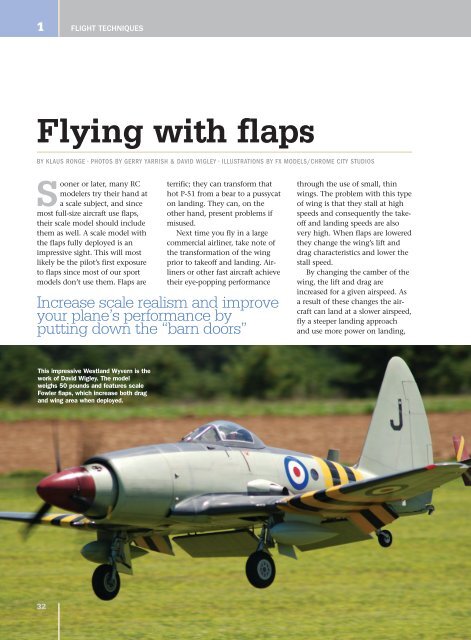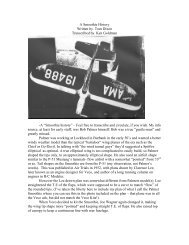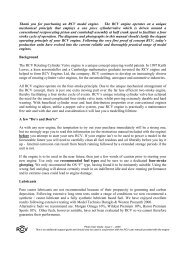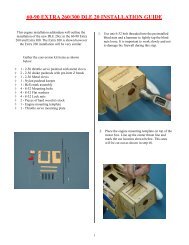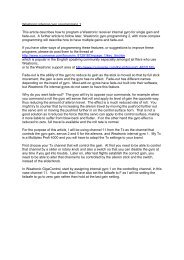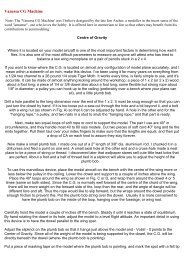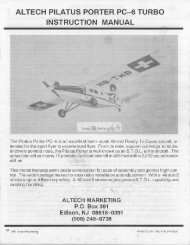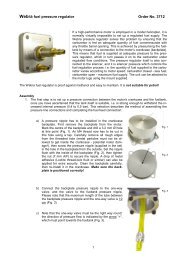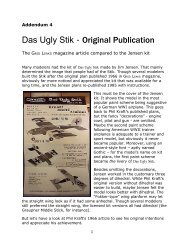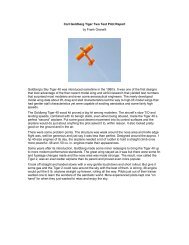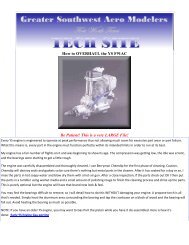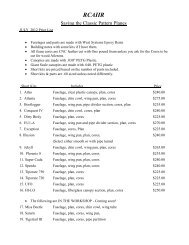Flying with flaps - Model Airplane News
Flying with flaps - Model Airplane News
Flying with flaps - Model Airplane News
Create successful ePaper yourself
Turn your PDF publications into a flip-book with our unique Google optimized e-Paper software.
ch1flighttechniques 1/28/08 11:08 AM Page 32<br />
1 BASICS FLIGHT TECHNIQUES<br />
<strong>Flying</strong> <strong>with</strong> <strong>flaps</strong><br />
BY KLAUS RONGE • PHOTOS BY GERRY YARRISH & DAVID WIGLEY • ILLUSTRATIONS BY FX MODELS/CHROME CITY STUDIOS<br />
Sooner or later, many RC<br />
modelers try their hand at<br />
a scale subject, and since<br />
most full-size aircraft use <strong>flaps</strong>,<br />
their scale model should include<br />
them as well. A scale model <strong>with</strong><br />
the <strong>flaps</strong> fully deployed is an<br />
impressive sight. This will most<br />
likely be the pilot’s first exposure<br />
to <strong>flaps</strong> since most of our sport<br />
models don’t use them. Flaps are<br />
terrific; they can transform that<br />
hot P-51 from a bear to a pussycat<br />
on landing. They can, on the<br />
other hand, present problems if<br />
misused.<br />
Next time you fly in a large<br />
commercial airliner, take note of<br />
the transformation of the wing<br />
prior to takeoff and landing. Airliners<br />
or other fast aircraft achieve<br />
their eye-popping performance<br />
Increase scale realism and improve<br />
your plane’s performance by<br />
putting down the “barn doors”<br />
through the use of small, thin<br />
wings. The problem <strong>with</strong> this type<br />
of wing is that they stall at high<br />
speeds and consequently the takeoff<br />
and landing speeds are also<br />
very high. When <strong>flaps</strong> are lowered<br />
they change the wing’s lift and<br />
drag characteristics and lower the<br />
stall speed.<br />
By changing the camber of the<br />
wing, the lift and drag are<br />
increased for a given airspeed. As<br />
a result of these changes the aircraft<br />
can land at a slower airspeed,<br />
fly a steeper landing approach<br />
and use more power on landing,<br />
This impressive Westland Wyvern is the<br />
work of David Wigley. The model<br />
weighs 50 pounds and features scale<br />
Fowler <strong>flaps</strong>, which increase both drag<br />
and wing area when deployed.<br />
32
ch1flighttechniques 1/28/08 11:08 AM Page 33<br />
RADIO CONTROL GIANT SCALE 1<br />
Do’s<br />
■ Learn how your plane reacts to <strong>flaps</strong><br />
at a safe altitude before attempting<br />
the first landing.<br />
■ Reduce the throttle to around 1⁄3<br />
and let the plane slow before dropping<br />
the <strong>flaps</strong>.<br />
■ If used for takeoff, use only<br />
partial <strong>flaps</strong>.<br />
■ Adjust the power to maintain the<br />
approach path. Flaps add drag and<br />
require more power.<br />
■ Add power on a go-around and<br />
begin a climbout before<br />
retracting <strong>flaps</strong>.<br />
Don’ts<br />
■ Deploy <strong>flaps</strong> at high speed. The<br />
<strong>flaps</strong> may depart the wings or cause<br />
serious structural or servo damage.<br />
■ Use <strong>flaps</strong> on the first takeoff and<br />
test flight. You must first determine<br />
how much deflection is correct for<br />
your model.<br />
■ Use full <strong>flaps</strong> on takeoff. This adds a<br />
lot of drag.<br />
■ Let the plane balloon and lose its<br />
airspeed. Adjust the elevator to keep<br />
the proper approach path.<br />
■ Retract <strong>flaps</strong> when low and slow or<br />
you could settle onto the runway.<br />
which is a good thing if you have<br />
to “go-around” <strong>with</strong> your model.<br />
FLAP VARIETIES<br />
There are four basic types of <strong>flaps</strong>:<br />
plain, split, Fowler and slotted.<br />
The plain flap is simply a hinged<br />
portion of the trailing edge. Split<br />
type <strong>flaps</strong> are hinged at the bottom<br />
of the wing and create much<br />
Big turbine-powered jets like this BVM Ultra Bandit are<br />
made for speed. Flaps greatly reduce its landing speed.<br />
Flaps also impart a large structural<br />
load on the plane and should only<br />
be used at a lower airspeed<br />
more drag than plain <strong>flaps</strong>. The<br />
slotted flap is similar to a plain<br />
flap, but has a slot between the<br />
wing’s trailing edge and the flap.<br />
The air passing through the slot<br />
delays the airflow separation and<br />
creates a greater increase in lift<br />
<strong>with</strong> a smaller increase in drag<br />
than a plain or split flap. Fowler<br />
<strong>flaps</strong> extend aft and down increasing<br />
the wings area and provide<br />
large increases in lift <strong>with</strong> a minimum<br />
of drag.<br />
Deflecting <strong>flaps</strong> will cause a<br />
twisting action to the airplanes’<br />
wing. The type of flap as well as<br />
the wing’s design will determine<br />
the amount of twisting action,<br />
<strong>with</strong> the split flap generating the<br />
least amount. Deploying the<br />
<strong>flaps</strong> may result in the plane<br />
pitching up or pitching down.<br />
The elevator must be used to<br />
compensate and keep the plane<br />
on the desired approach path.<br />
Another characteristic of <strong>flaps</strong> is<br />
that the first half of the flap’s<br />
deflection results in a greater<br />
increase in lift while the second<br />
half results in a greater increase<br />
in drag. Flaps also impart a large<br />
structural load on the plane and<br />
should only be used at a lower<br />
airspeed. Full-size planes have<br />
their airspeed indicators marked<br />
for safe flap operating range.<br />
FLYING WITH FLAPS<br />
Since every aircraft reacts differently<br />
to <strong>flaps</strong>, it’s important to<br />
learn how yours reacts before<br />
committing to landing. The safest<br />
Fowler <strong>flaps</strong> move rearward and downward<br />
increasing the wing area and curvature.<br />
Plain <strong>flaps</strong> lower the wing’s trailing edge<br />
increasing its curvature and, therefore, its lift.<br />
33
ch1flighttechniques 1/28/08 11:08 AM Page 34<br />
1 FLIGHT TECHNIQUES<br />
Slotted <strong>flaps</strong> allow high-energy air to flow from underneath the<br />
wing up and over the flap to help prevent airflow separation.<br />
Split <strong>flaps</strong> generate a lot of drag by disturbing<br />
the airflow on the underside of the wing.<br />
way is to do a no-flap takeoff and<br />
fly your model around to get<br />
comfortable <strong>with</strong> it. At a safe<br />
height, reduce the throttle to<br />
about 1 ⁄3 and let the plane slow<br />
down. Next, add 1 ⁄2 <strong>flaps</strong> and see<br />
what your plane does. If it balloons<br />
(pitches nose-up), apply<br />
some down-elevator to help maintain<br />
the airspeed. Once the plane<br />
is under control again, add full<br />
<strong>flaps</strong> and be prepared to adjust<br />
the elevator pressure on the stick.<br />
You may be surprised how much<br />
elevator it takes to compensate for<br />
full flap deflection and how much<br />
the plane will slow down. With<br />
today’s radio systems, it’s easy to<br />
program a mix for the proper<br />
amount of elevator trim when the<br />
<strong>flaps</strong> are dropped. This will greatly<br />
ease the pilot’s workload.<br />
Once you are comfortable <strong>with</strong><br />
flying the plane <strong>with</strong> the <strong>flaps</strong><br />
You may be surprised how much<br />
elevator correction it takes to<br />
compensate for full flap deflection<br />
down, it’s time for the landing. If<br />
you have your <strong>flaps</strong> set up to drop<br />
in increments, such as a dial or<br />
slider switch, add about 10 degrees<br />
on downwind after the plane<br />
passes your position and then add<br />
about 1 ⁄2 (20 to 25 degrees) on<br />
base leg. After turning, add full<br />
<strong>flaps</strong> and use power to adjust the<br />
flight path. Remember, you will<br />
need more power <strong>with</strong> <strong>flaps</strong> and<br />
the approach descent rate will be<br />
steeper. With a little practice, you<br />
will be rewarded <strong>with</strong> pictureperfect<br />
landings.<br />
Since <strong>flaps</strong> provide more lift at<br />
slower airspeeds, you must be<br />
Nick Ziroli greases in another landing<br />
<strong>with</strong> his Skyraider. Effective use of<br />
<strong>flaps</strong> allow this 100-inch model to<br />
land at a reasonable airspeed.<br />
34
ch1flighttechniques 1/28/08 11:08 AM Page 35<br />
RADIO CONTROL GIANT SCALE 1<br />
The Top Flite B-25 Mitchell bomber<br />
has inboard and outboard <strong>flaps</strong><br />
because of its twin wing-mounted<br />
engine nacelles. With the <strong>flaps</strong><br />
deployed, this impressive warbird<br />
ARF lands like a trainer.<br />
FLAP ACTION<br />
Flaps impart a tremendous load on the wing and require attention during their installation. Make sure you use<br />
enough heavy-duty hinges on each flap and a heavy-duty control horn. There are many ways to actuate the<br />
<strong>flaps</strong>, including torque tubes and bell cranks. For large, fast or heavily-loaded models, the best way is to use a<br />
servo for each flap. These planes will also benefit from the <strong>flaps</strong> being locked in the down position preventing<br />
the airstream from blowing the flap back to the up position. This basically means that the servo arm is directly in<br />
line <strong>with</strong> the flap horn at full deflection and this takes the strain away from the servo. This is accomplished by<br />
turning on the radio and selecting full down <strong>flaps</strong> and choosing a servo horn position that is in line <strong>with</strong> the<br />
horn. Now, retract the <strong>flaps</strong> and make up the linkage from the servo to the horn. The amount of flap deflection<br />
is determined by the length of the servo arm; for more flap deflection, place the linkage farther out on the arm.<br />
The use of ball links may be required for smooth action and to eliminate binding.<br />
The modeler has several options for the transmitter flap actuation method. The least desirable is to use a<br />
two-way switch, which only results in <strong>flaps</strong> up or full down. This is not very scale-like and could result in large<br />
pitch changes when the <strong>flaps</strong> are actuated. A three-position switch will allow the use of half-<strong>flaps</strong> for more<br />
scale-like flight. A knob or slider switch is another way to go and allows an infinite number of flap settings. The<br />
only drawback is that it is sometimes difficult to tell how much flap deflection is selected.<br />
aware that when you retract them<br />
in-flight you will lose the lift and<br />
the plane could sink. For this reason,<br />
if you must do a go-around,<br />
make sure you increase power<br />
before retracting the <strong>flaps</strong>. Failure<br />
to do so could place your plane<br />
very close to stall speed before<br />
you can accelerate to a safe speed.<br />
This also applies to takeoffs <strong>with</strong><br />
<strong>flaps</strong>. In most cases it is safer to<br />
take off <strong>with</strong> the <strong>flaps</strong> retracted or<br />
deflected no more than about 20<br />
degrees. Larger deflections add<br />
more drag and can cause the<br />
plane to become airborne at too<br />
low of an airspeed.<br />
<strong>Flying</strong> a scale model <strong>with</strong><br />
operational <strong>flaps</strong> is a very<br />
rewarding experience. Not only<br />
do they look neat, but they also<br />
provide the same benefits as the<br />
full-size version. They take the<br />
anxiety out of landing your leadsled<br />
WW II fighter or similar<br />
high-performance aircraft and<br />
provide a safer and more enjoyable<br />
RC experience.<br />
35


